
The Bottom Line
Introduction, Specifications, Pricing & Availability
Crucial's BX Series is their value line of SATA-based SSDs. Crucial's MX Series is their enthusiast line of SATA SSDs. To this point, the MX series has always held a sizable performance advantage over the value-oriented BX Series. With the BX300, the line has become blurred. The reason for this is the BX300 is the first Crucial SSD to feature 3D MLC (2-bit) flash.

Crucial has learned a lot from their previous BX Series SSDs and have applied that knowledge and experience toward making the BX300 one of the best price to performance values on the market today. The BX300 is indeed targeted at first-time SSD upgraders. As such, the BX300 is only offered in three capacities - 120, 240 and 480GB. This makes sense for a value line of SSDs because 240GB is overall the best-selling capacity point and new adopters aren't usually willing to shell out a lot of money for an SSD experience.
So, what can you expect when you upgrade your spinning rust bucket to a Crucial BX300? Your computer will boot in seconds, apps load almost instantly and files save faster. Crucial says the BX300 will give you about 300% better performance than a traditional mechanical HDD. The BX300 runs cooler, quieter (silent) and consumes far less power than an HDD.
Lower power consumption means longer battery life for laptop users. Crucial claims the BX300 is 90% more power efficient than an HDD. Additionally, SSDs are far more reliable than mechanical storage media. SSDs are superior to HDDs on all fronts. Once you have an SSD experience, you will never want to go back.
Crucial wants to make your transition to an SSD as seamless as possible. The BX300 comes with a free Acronis HD key. Acronis is the industry standard for easily cloning your existing HDD to a super-fast SSD. No need to reinstall your OS and applications; just clone in minutes and enjoy life in the fast lane. If that task seems a bit daunting,
Crucial again has you covered. Crucial offers a mobile-friendly guide for first-timers. The guide offers tips, videos and instructions that will help guide you along. If you still need assistance, Crucial also offers chat, phone, and email customer support to help with the install process. In addition to cloning software, the BX300 is fully compatible with Crucial's Storage Executive SSD software. Storage Executive allows for easy monitoring, maintenance and tuning of your Crucial SSD.
Storage Executive enables you to see how much storage you've used, monitor your drive's temperature, and enable the Momentum Cache feature, which makes SSD operations up to 10x faster. Momentum Cache allocates a small portion of system DRAM as a write buffer greatly increasing burst performance. Have a look at our Maxed-Out Performance (MOP) page to see what enabling Momentum Cache does to boost performance.
The power behind the BX300 is, as mentioned, its 3D MLC flash array. The value part comes from Crucial being the consumer arm of Micron. Micron is one of the world's largest manufactures of NAND Flash, and as such, they can deliver flash-based products much cheaper than third party vendors. Crucial can offer 3D MLC Flash-based SSDs for the same price as their competitors' TLC (3-bit) Flash-based SSDs. This is a big deal because MLC is superior to TLC for several reasons.
MLC performance is better than 3-bit, because it is faster to program 2-bits than it is 3-bits. MLC endurance is also better because 2-bit cells survive considerably more program/erase cycles than 3-bit cells. Power consumption is lower for MLC than it is TLC, because it takes less power to program 2-bits than it does 3-bits.
Crucial has once again teamed up with Silicon Motion. The BX300 is powered by SMI's venerable SM2258 SATA III controller. SMI's SM2258 4-channel controller has won us over because it delivers outstanding consumer workload performance, has proven itself to be one of the most reliable SATA controllers ever made and offers a ton of features. Those features include DEVSLP extreme low-power mode, active garbage collection, TRIM, SLC write acceleration, multistep data integrity, advanced error correcting technology and thermal monitoring.
A 3D MLC flash array paired with SMI's SM2258 controller sounds like a delicious combo to us, let's see how the BX300 performs.
Factory Specifications
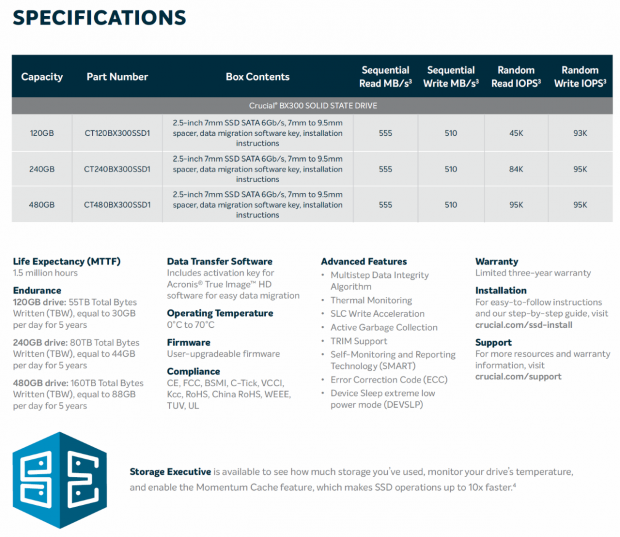
Crucial BX300 240GB SATA III SSD:
- Sequential Read: up to 550 MB/s
- Sequential Write: up to 510 MB/s
- Max 4K Random Read Speed: up to 84,000 IOPS
- Max 4K Random Write Speed: up to 95,000 IOPS
- Endurance: 80TB
- MTBF: 1.5 Million Hours
- Warranty: 3-Year Limited Warranty
- ECC
- SMART
- TRIM
- Garbage Collection
- Software: Storage Executive, Acronis True Image HD Migration Software
Current Pricing: $87.99
Crucial pairs Silicon Motion's SM2258 controller with Micron 256Gbit 32-layer 3D MLC (Multi-Level-Cell) flash in BGA flash packages. Micron 256Gbit 2-bit 3D flash is built on proven floating gate architecture and manufacturing process. Floating gate technology gives Micron 3D flash the industry's highest areal density available today and CMOS under array keeps the footprint compact. BGA packaged flash is the good stuff, it is capable of higher bus speeds than TSOP packaged flash. Table caching is handled by a single Micron DDR3 DRAM cache package with a capacity of 1MB to 1GB DRAM to NAND ratio.
Drive Details
Crucial BX300 240GB SATA III SSD
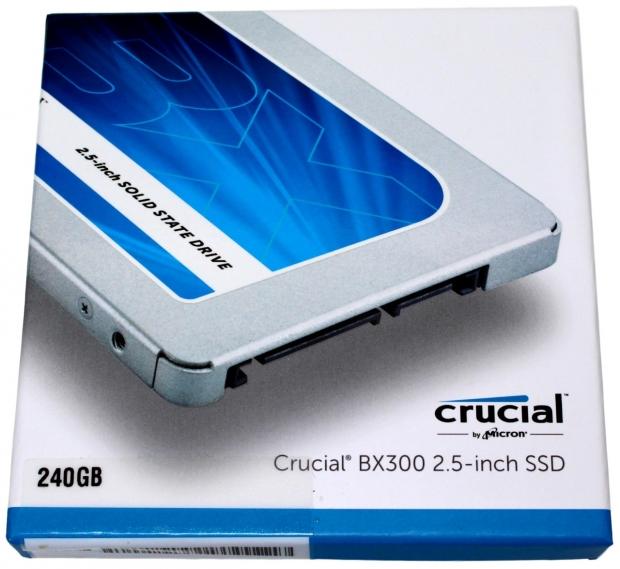
The front of the packaging features an image of the BX300. Capacity and form-factor are advertised here.
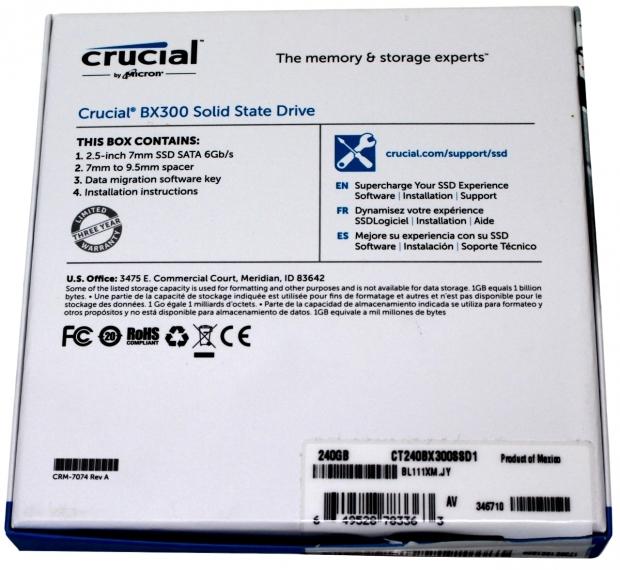
The rear of the packaging lists the contents, 3-year warranty and advertises Crucial's support channel.
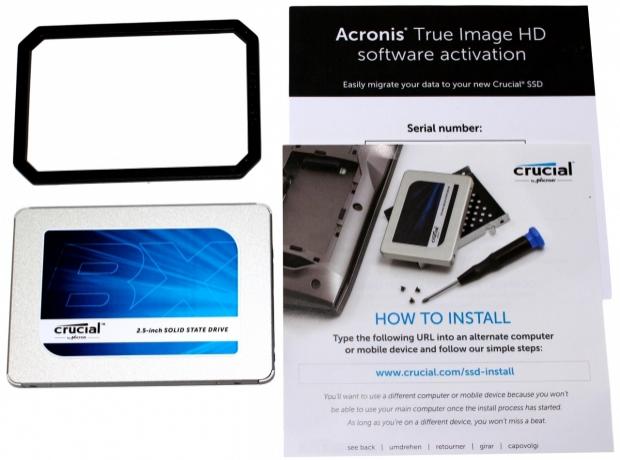
Contained within the packaging is the drive, a stick-on spacer, Acronis key and a web address for Crucial's installation support.
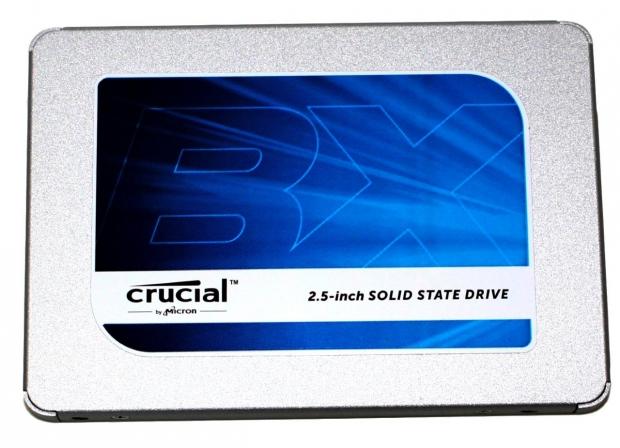
The drive's enclosure is formed from sheet aluminum. There is an attractive label at the center.
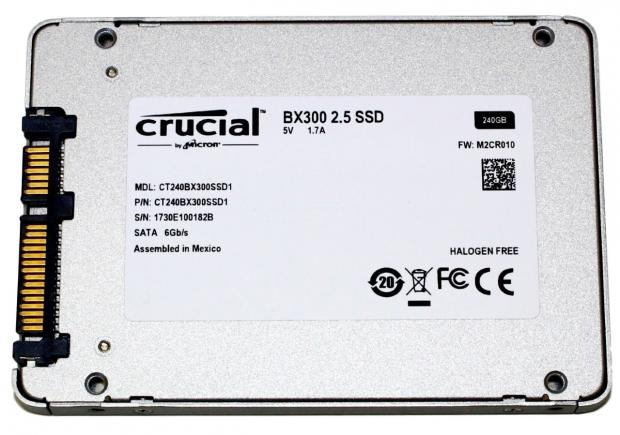
The bottom and sides of the enclosure are also formed from sheet aluminum. There is a manufacturer's label listing the particulars of the drive.
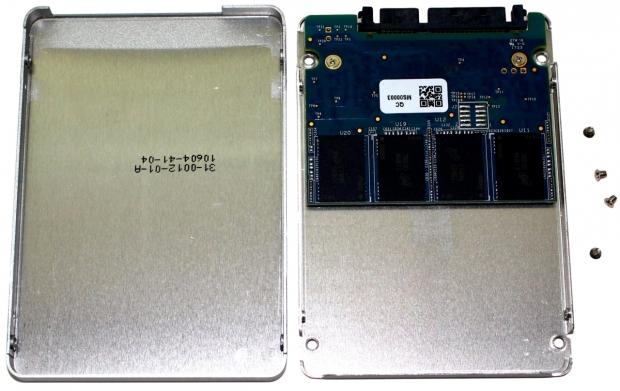
Popping the enclosure open reveals the back-side of a half-length PCB.
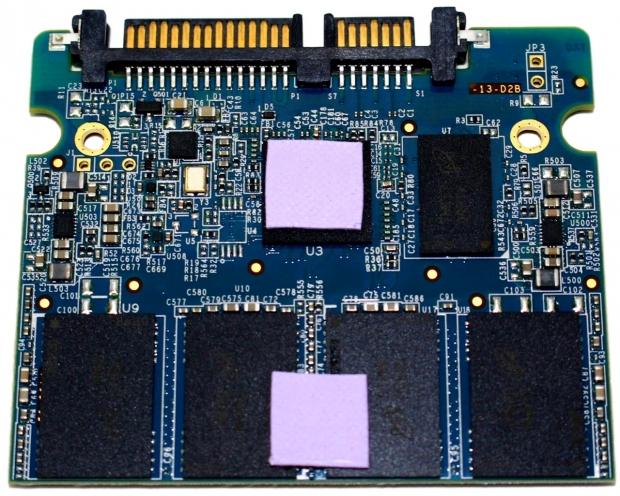
There are two thermal pads on the drive's components. One on the controller and one spanning across two of the drive's flash packages.
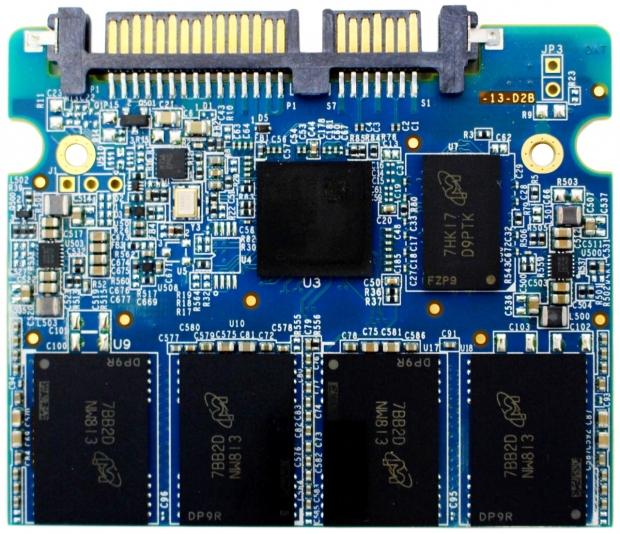
This side of the PCB houses four of the drive's eight 32GB, 32-layer 3D MLC flash packages, its Silicon Motion SM2258 4-channel controller and a Micron 256MB DDR3 DRAM package.
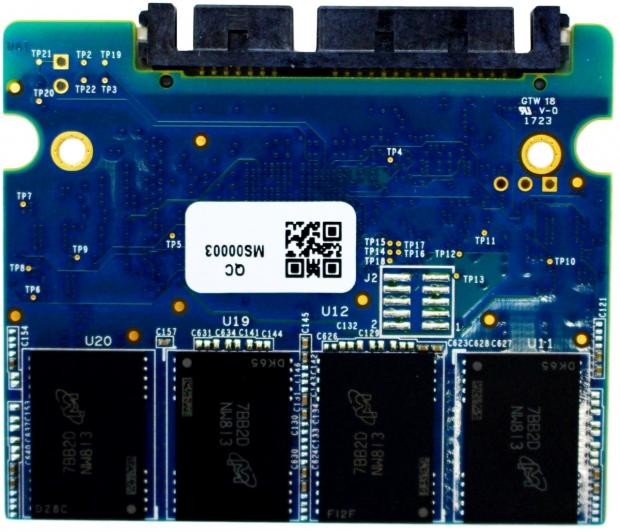
This side of the PCB houses four of the drive's eight 32GB, 32-layer 3D MLC flash packages.
Test System Setup and Properties
Jon's Consumer SSD Review Test System Specifications
- Motherboard: ASRock Extreme9 Z97 - Buy from Amazon
- CPU: Intel Core i7 4790K @ 4.8GHz - Buy from Amazon / Read our review
- Cooler: Swiftech H2O-320 Edge - Buy from Amazon / Read our review
- Memory: Corsair Dominator DDR3 32GB 2400MHz - Buy from Amazon
- Video Card: Onboard Video
- Case: IN WIN X-Frame - Buy from Amazon / Read our review
- Power Supply: Seasonic Platinum 1000 Watt Modular - Buy from Amazon / Read our review
- OS: Microsoft Windows 10 Professional 64-bit - Buy from Amazon
- Drivers: Intel RAID option ROM version 13.0.0.2075 and Intel RST driver version 14.8.0.1042
We would like to thank ASRock, Crucial, Intel, Corsair, RamCity, IN WIN, and Seasonic for making our test system possible.
Drive Properties & Storage Executive
Crucial BX300 240GB SATA III SSD OS Disk 75% Full
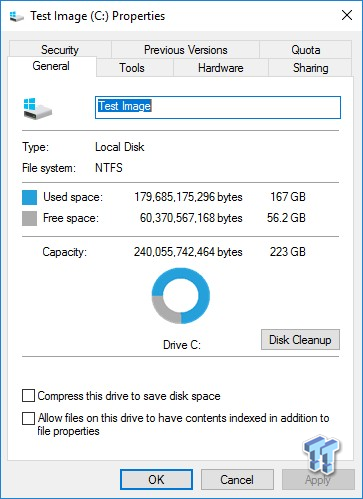
The majority of our testing is performed with our test drive as our boot volume. Our boot volume is 75% full for all OS Disk "C" drive testing to replicate a typical consumer OS volume implementation. We feel that most of you will be utilizing your SSDs for your boot volume and that presenting you with results from an OS volume is more relevant than presenting you with empty secondary volume results.
System settings: Cstates and Speed stepping are both disabled in our systems BIOS. Windows High-Performance power plan is enabled. Windows write caching is enabled, and Windows buffer flushing is disabled. We are utilizing Windows 10 Pro 64-bit OS for all of our testing except for our MOP (Maxed-Out Performance) benchmarks where we switch to Windows Server 2008 R2 64-bit. Empty Windows 10 benchmark screenshots will also be shown on our MOP page.
Please note: When comparing our results to those of other review sites, look at page 10 Maxed Out Performance-Windows 10 which is done with the disk empty.
Crucial Storage Executive SSD Utility
The BX300 is fully compatible with Crucial's Storage Executive SSD Utility. The utility makes drive maintenance and monitoring simple and easy to understand.
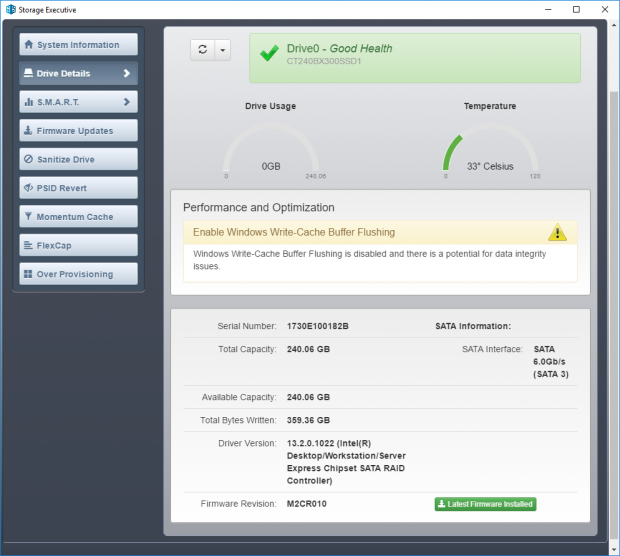
The Drive Details tab tells us what firmware is on the drive, the drive's temperature, health, interface, and will alert us if there are any issues.
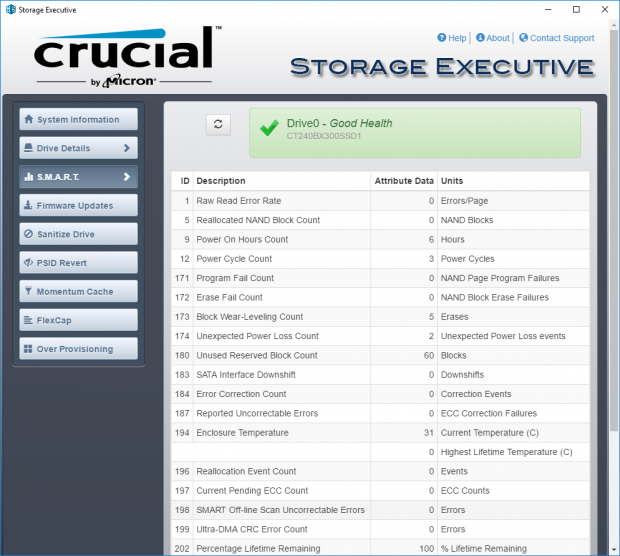
The S.M.A.R.T. tab gives us a breakdown of the drive's health status.
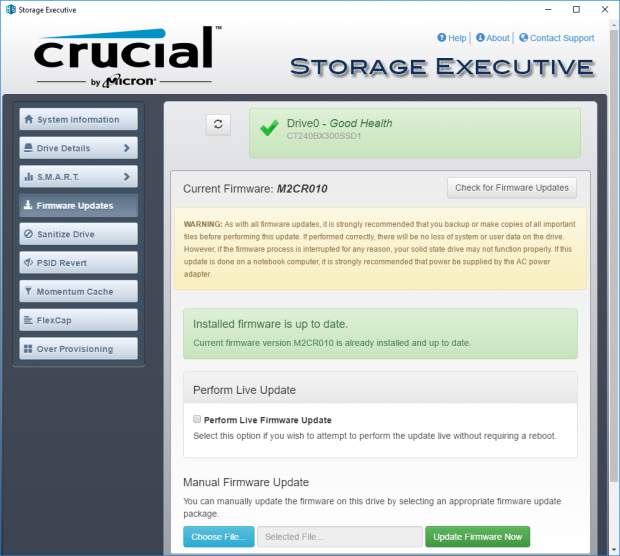
You can easily update the drive's firmware with a couple clicks.
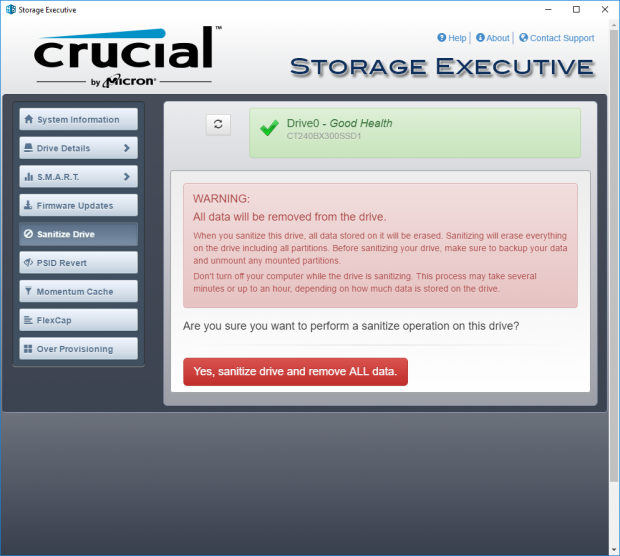
The Sanitize Drive tab allows you to secure erase the drive.
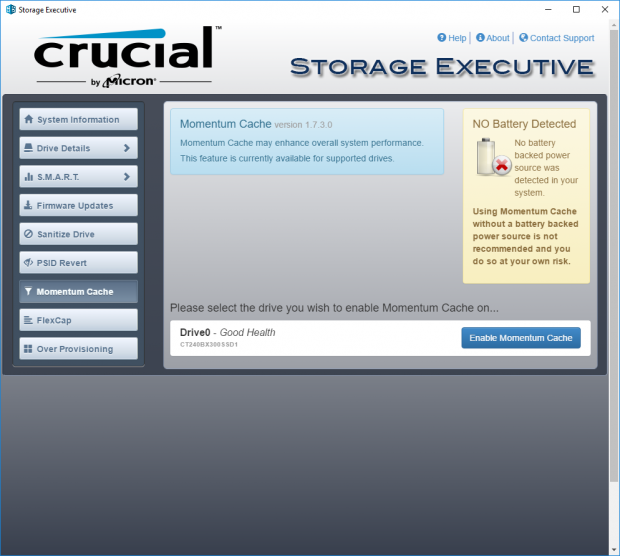
You can enable Momentum Cache from this tab. Please see our Maxed-Out Performance page for results with Momentum Cache enabled.
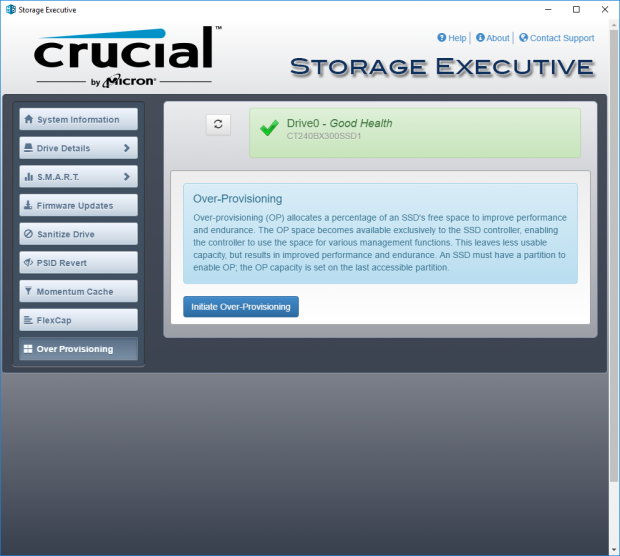
Here you can easily over-provision the drive for better-sustained performance.
Synthetic Benchmarks - ATTO & Anvil's
ATTO
Version and / or Patch Used: 2.47
ATTO is a timeless benchmark used to provide manufacturers with data used for marketing storage products. With ATTO, we are looking at maximum sequential performance with compressible data as well as the performance curve.
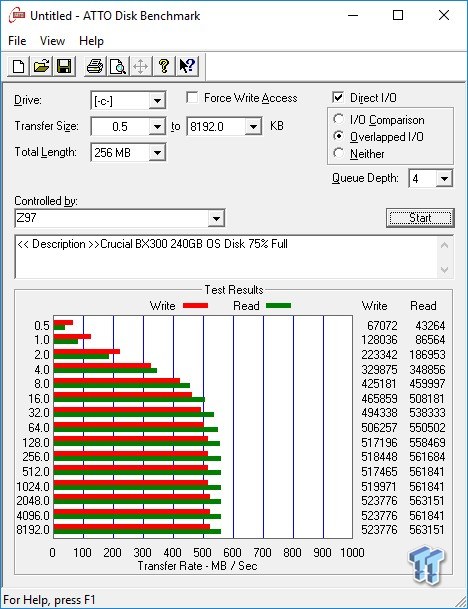
Compressible sequential read/write transfers max out at 561/523 MB/s. Keep in mind this is our OS volume, and it is filled to 75% of its total capacity.
Sequential Write
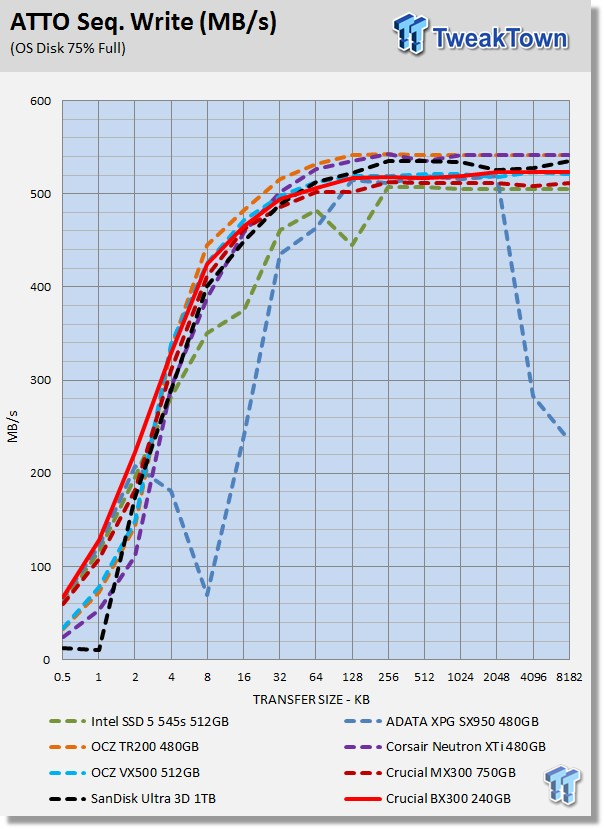
A smooth performance curve and excellent small-file performance are what we are looking for and the BX300 delivers the goods.
Sequential Read
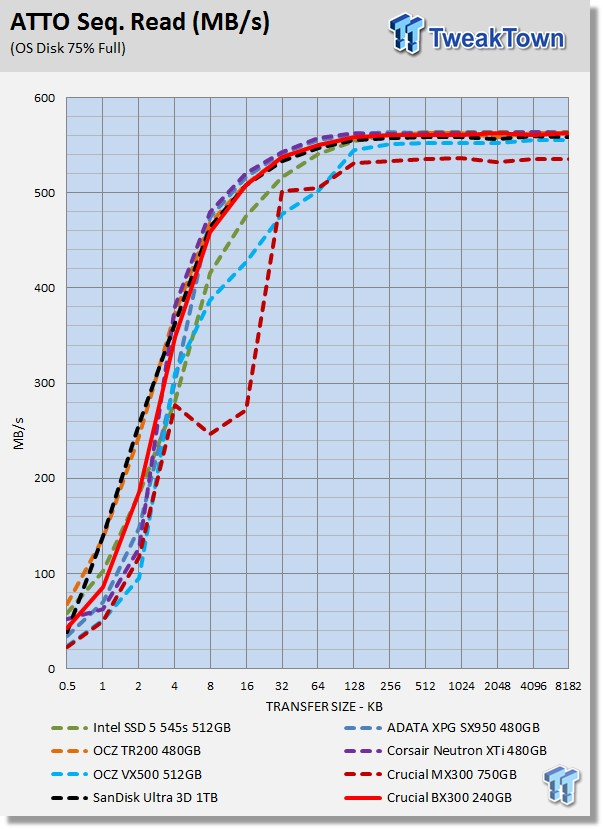
More of what we are looking for. Excellent small-file performance, smooth performance curve and high top-end speed.
Anvil Storage Utilities
Version and / or Patch Used: 1.1.0
Anvil's Storage Utilities is a storage benchmark designed to measure the storage performance of SSDs. The Standard Storage Benchmark performs a series of tests; you can run a full test or just the read or write test, or you can run a single test, i.e. 4K QD16. With Anvil's, we are focused on the total score.
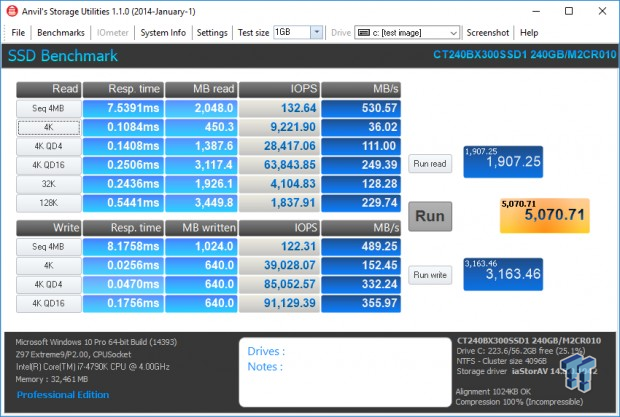
Scoring
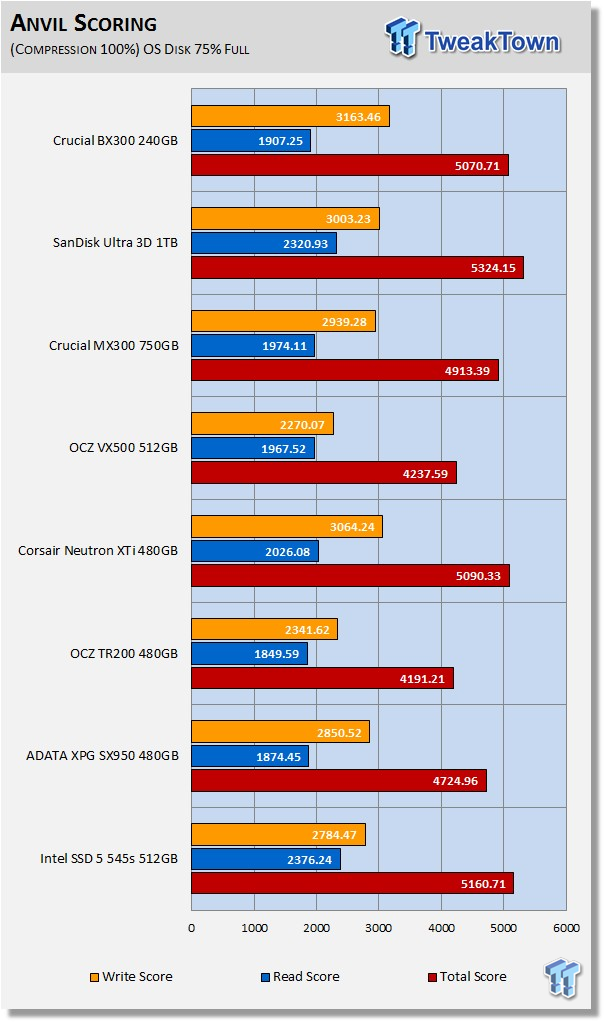
Anvil's scoring typically provides us with a good indication of a drive's overall synthetic performance. Whenever a SATA SSD scores 5,000 we take notice. Not many drives can do it, and this is the first time we've seen a Micron 3D flash equipped SATA drive hit our milestone mark. And, this is despite its capacity handicap at 240GB.
(Anvil) Read IOPS through Queue Depth Scale
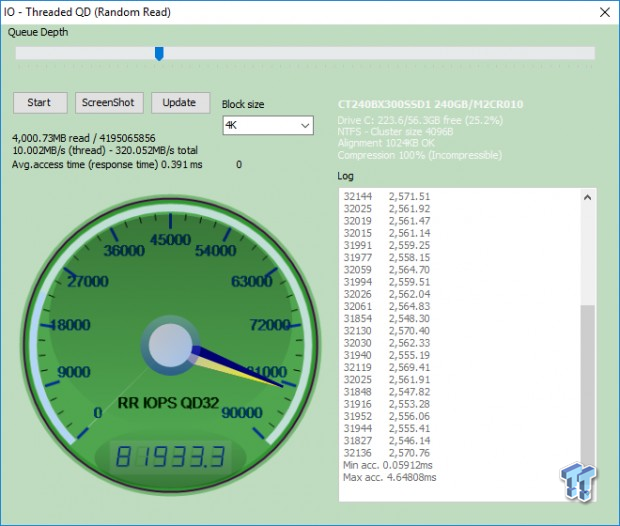
With the drive filled to 75% of its total capacity, we fall short of the 84K random read IOPS listed on the factory spec. sheet.
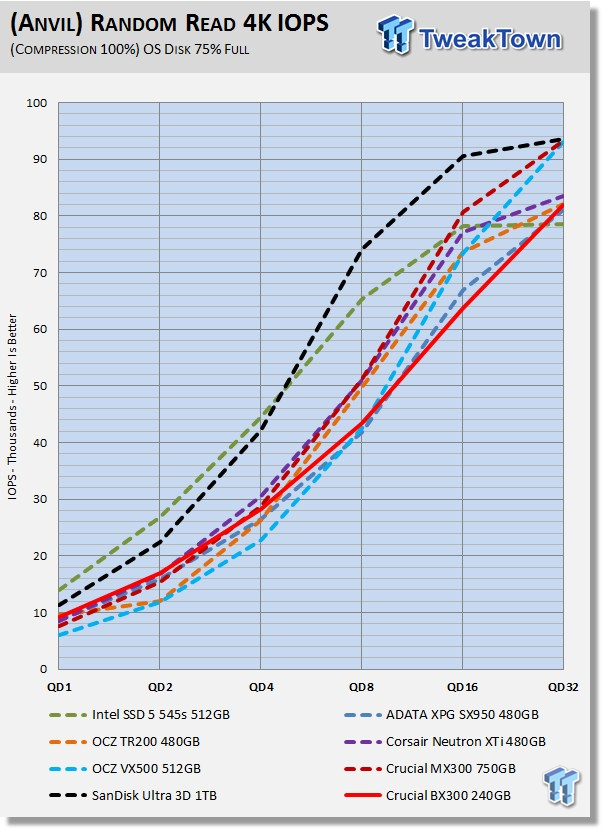
The BX300 delivers respectable performance at QD1-QD2, but at higher queue depths, falls behind most of the drives in our test pool.
(Anvil) Write IOPS through Queue Scale
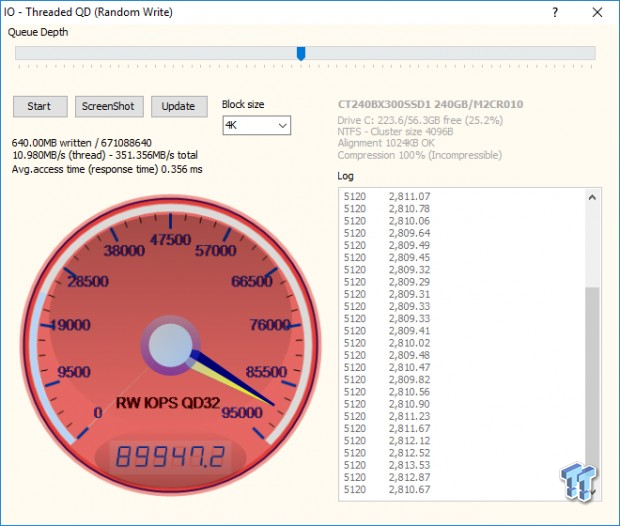
With the drive filled to 75% of its total capacity, we fall short of the 95K random write IOPS listed on the factory spec. sheet.
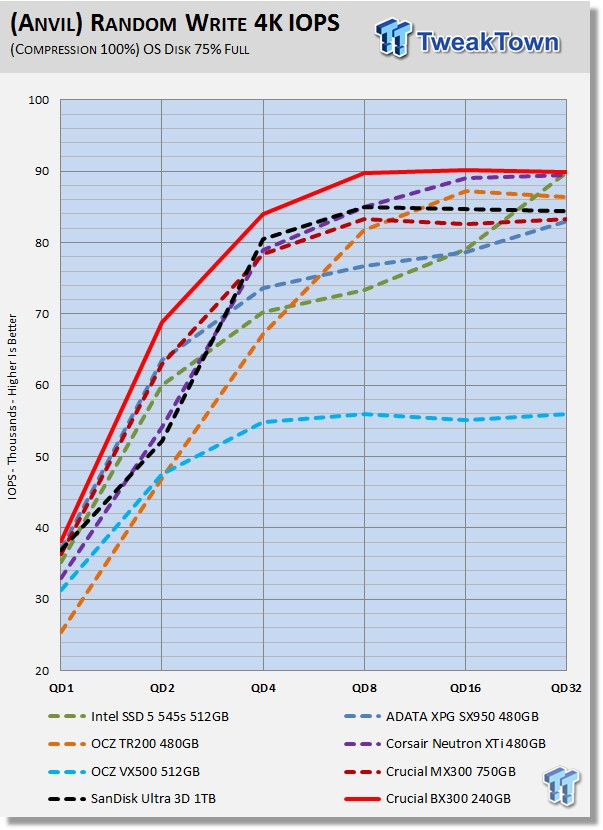
The BX300 absolutely owns the competing drives in our test pool when writing random data. The XPG SX950 is similarly configured (same controller and same flash) but can't hang with the BX300 despite its capacity advantage.
Synthetic Benchmarks - CDM & AS SSD
CrystalDiskMark
Version and / or Patch Used: 3.0 Technical Preview
CrystalDiskMark is disk benchmark software that allows us to benchmark 4K and 4K queue depths with accuracy. Note: Crystal Disk Mark 3.0 Technical Preview was used for these tests since it offers the ability to measure native command queuing at QD4. With this version of CDM, we are focused on 4K random performance at QD1 and QD4.
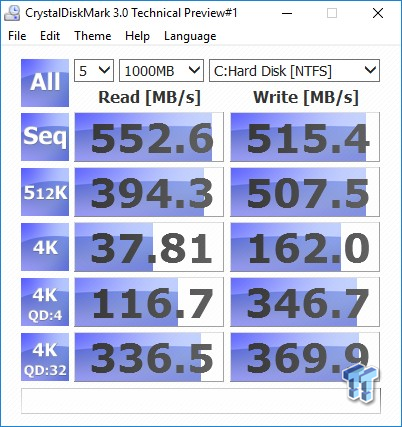
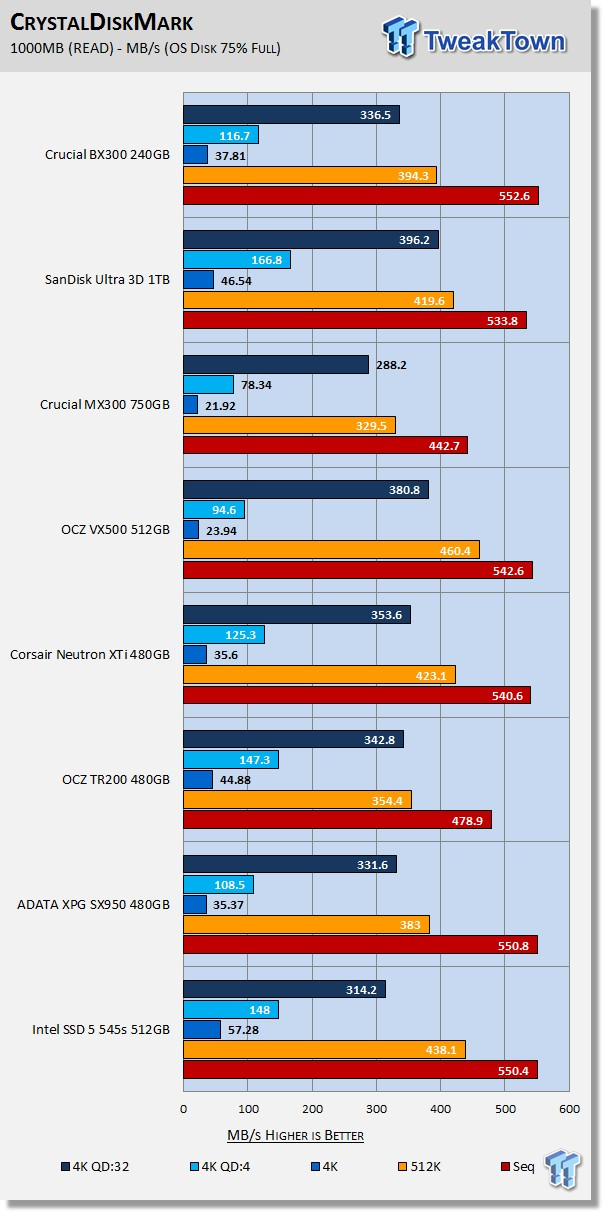
Like we saw from our Anvil testing, the BX300 is more of a write centric SSD and only delivers average random read performance. However, when we look at sequential read, we find the BX300 is the top performer. Here again, the BX300 outperforms the similarly configured XPG SX950 even with a capacity disadvantage.
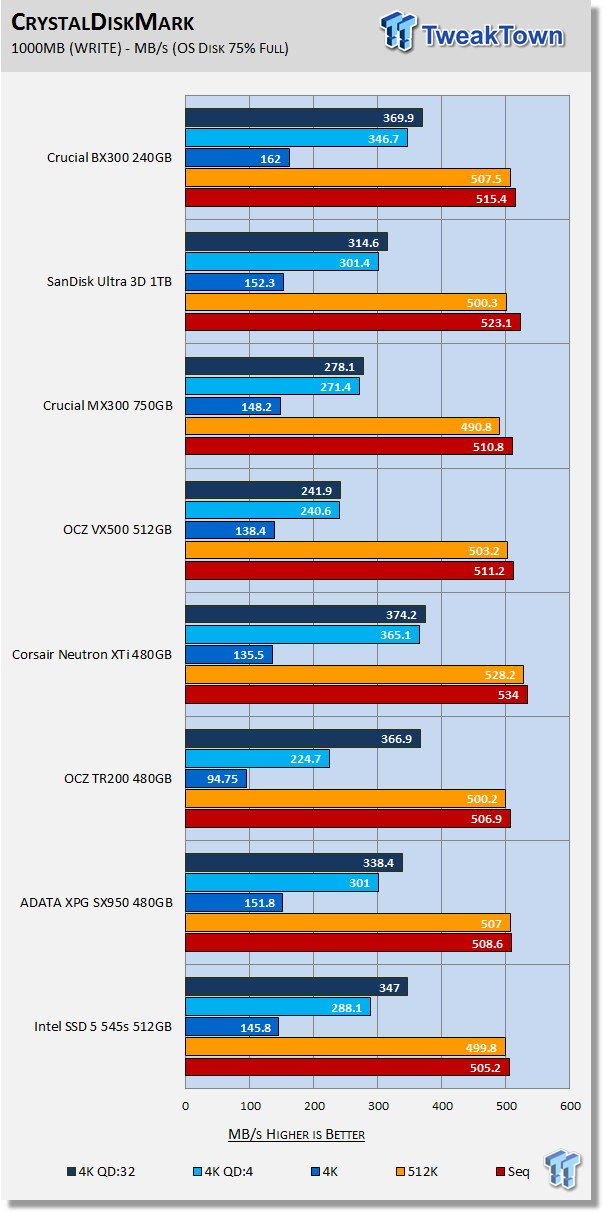
The BX300 delivers the goods where it matters most - QD1, beating all contenders in our test pool by a significant margin. The BX300 continues to assert its dominance over the SX950. Both drives have the same physical components, so the BX300 either has higher grade flash or better firmware.
AS SSD
Version and / or Patch Used: 1.8.5611.39791
AS SSD determines the performance of SSDs. The tool contains four synthetic as well as three practice tests. The synthetic tests are to determine the sequential and random read and write performance of the SSD. We focus on total score when evaluating AS SSD.
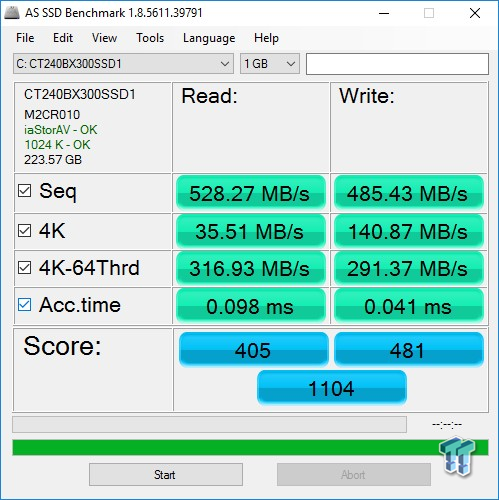
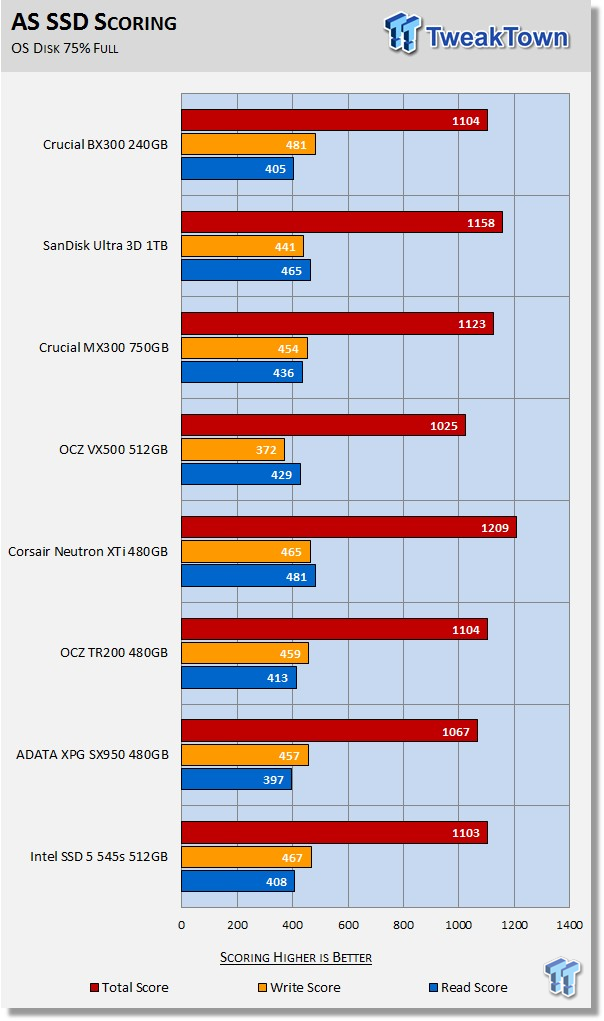
AS SSD is a demanding test. With AS SSD we are looking for a minimum score of 1000. The BX300 nails it, even though with this test the BX300 at 240GB is at a major disadvantage compared with the higher capacity drives in our test pool.
Benchmarks - Vantage, PCMark 7, PCMark 8 & SYSmark 2014 SE
Consumer Workloads
We categorize these tests as indicative of a moderate workload environment.
PCMark Vantage - Hard Disk Tests
Version and / or Patch Used: 1.2.0.0
The reason we like PCMark Vantage is because the recorded traces are played back without system stops. What we see is the raw performance of the drive. This allows us to see a marked difference between scoring that other trace-based benchmarks do not exhibit. An example of a marked difference in scoring on the same drive would be empty vs. filled vs. steady state.
We run Vantage three ways. The first run is with the OS drive 75% full to simulate a lightly used OS volume filled with data to an amount we feel is common for most users. The second run is with the OS volume written into a "Steady State" utilizing SNIA's guidelines. Steady state testing simulates a drive's performance similar to that of a drive that been subjected to consumer workloads for extensive amounts of time. The third run is a Vantage HDD test with the test drive attached as an empty, lightly used secondary device.
OS Volume 75% Full - Lightly Used
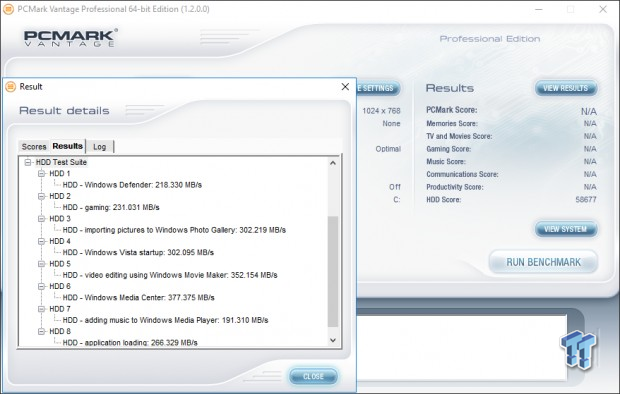
OS Volume 75% Full - Steady State
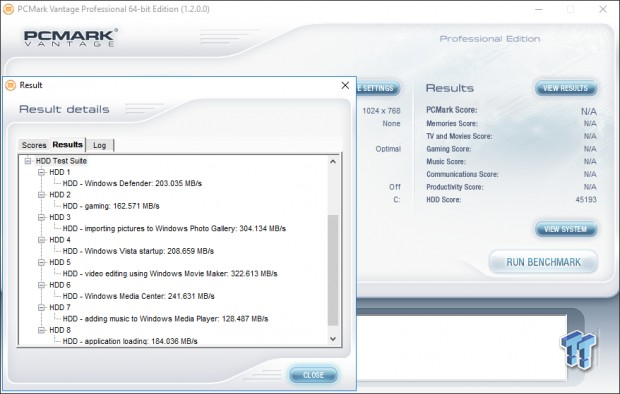
Secondary Volume Empty - FOB
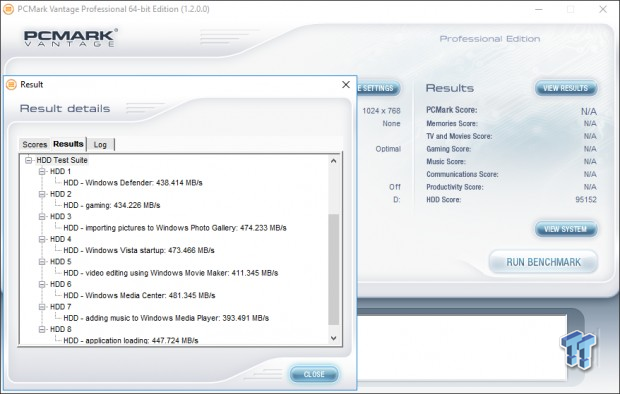
There's a big difference between an empty drive, one that's 75% full/used, and one that's in a steady state.
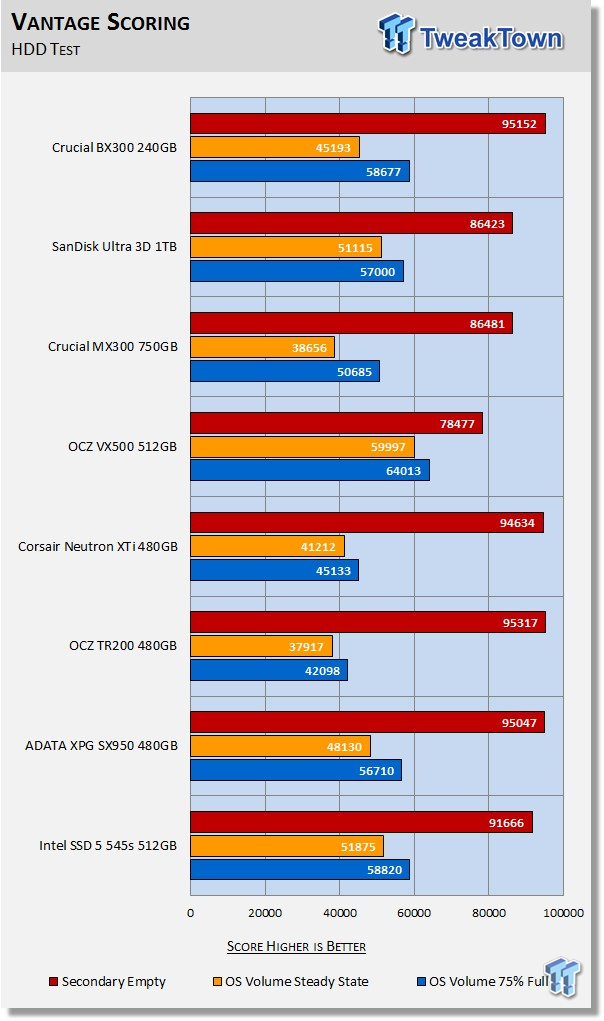
The important scores to pay attention to are "OS Volume Steady State" and "OS Volume 75% full." These two categories are most important because they are indicative of typical consumer user states. When a drive is in a steady state, it means garbage collection is running at the same time it's reading/writing. This is exactly why we focus on steady-state performance.
At 75% full, the BX300 delivers Tier-1 performance. However, it does take a bit of a beating when in a steady state. The Crucial MX300 uses 3-bit Micron 32-layer 3D flash, and we can clearly see that in a steady state, the 2-bit equivalent used on the BX300 delivers much better performance.
PCMark 7 - System Storage
Version and / or Patch Used: 1.4.0
We will look to Raw System Storage scoring for evaluation because it's done without system stops and, therefore, allows us to see significant scoring differences between drives.
OS Volume 75% Full - Lightly Used
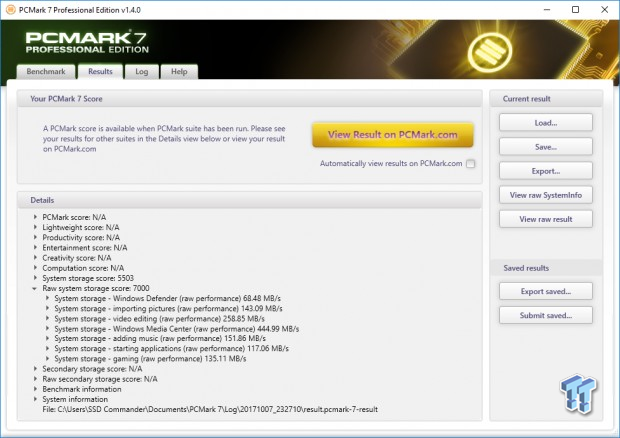
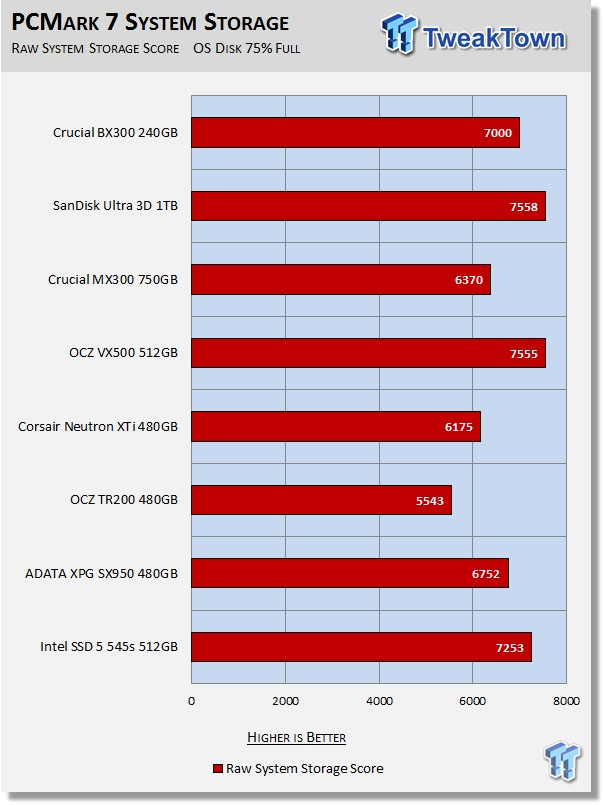
One of our internal markers that we use to determine if a SATA SSD is a Tier-1 class drive is a score of 7000. The BX300 makes the cut. Keep in mind that the BX300 we are testing is significantly handicapped by its capacity in comparison to the rest of the drives in our test pool.
PCMark 8 - Storage Bandwidth
Version and / or Patch Used: 2.4.304
We use PCMark 8 Storage benchmark to test the performance of SSDs, HDDs, and hybrid drives with traces recorded from Adobe Creative Suite, Microsoft Office, and a selection of popular games. You can test the system drive or any other recognized storage device, including local external drives. Unlike synthetic storage tests, the PCMark 8 Storage benchmark highlights real-world performance differences between storage devices. We focus on the total storage bandwidth when evaluating PCMark 8 results.
OS Volume 75% Full - Lightly Used
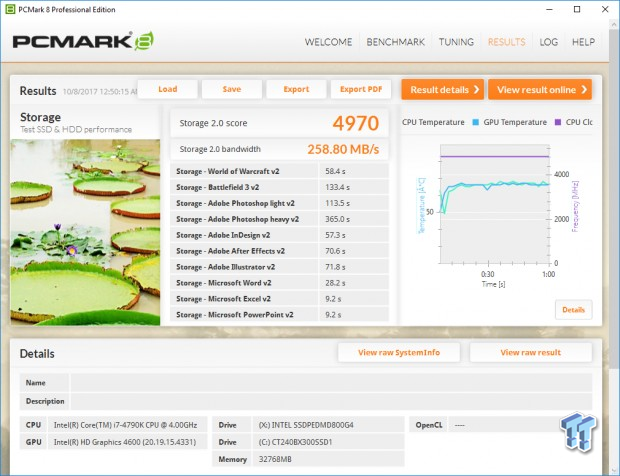
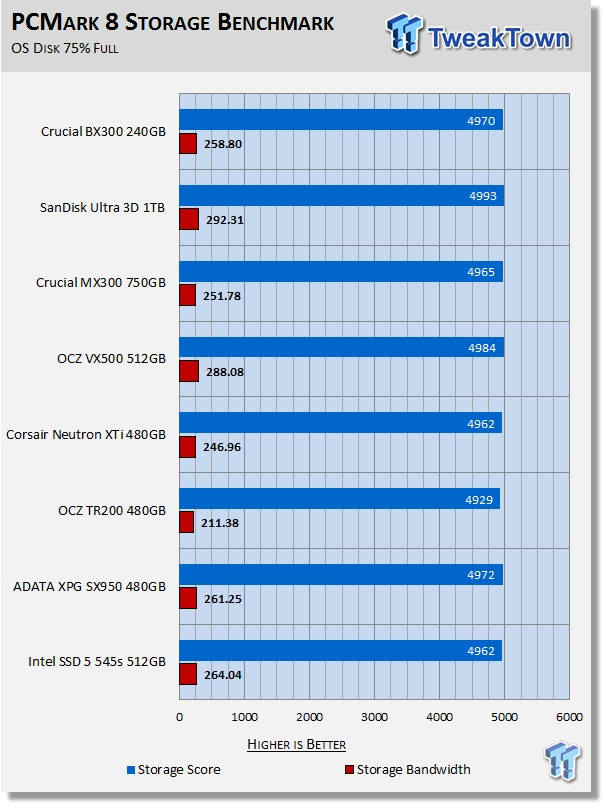
PCMark 8 is the most intensive moderate workload simulation we run. With respect to moderate workloads, this test is what we consider the best indicator of a drive's overall performance. Considering that the BX300 we are testing is only 240GB, this is a very good score. Capacity makes a big difference when running this particular test.
BAPCo SYSmark 2014 SE System Performance
Version and / or Patch Used: 2.0.0.70
SYSmark 2014 SE is considered the gold standard for testing system performance because it is an application based benchmark. This test gives us the ultimate in real-world results because it utilizes actual applications running on the system, instead of playing back recorded traces. If you want to know what kind of impact a particular SSD will have on your system's overall performance; this test will show you.
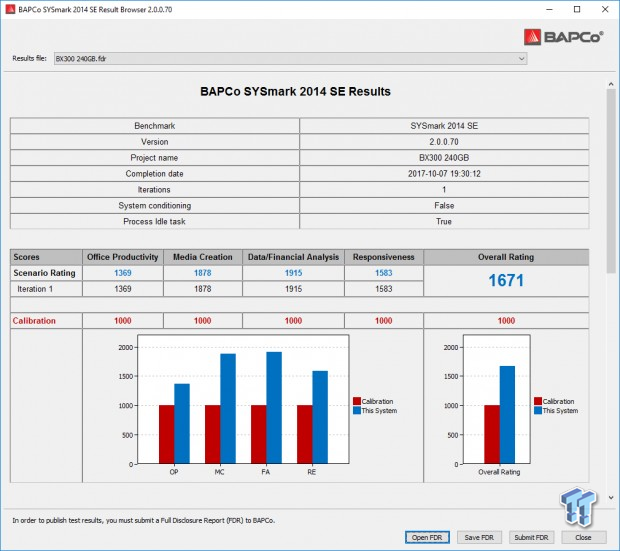
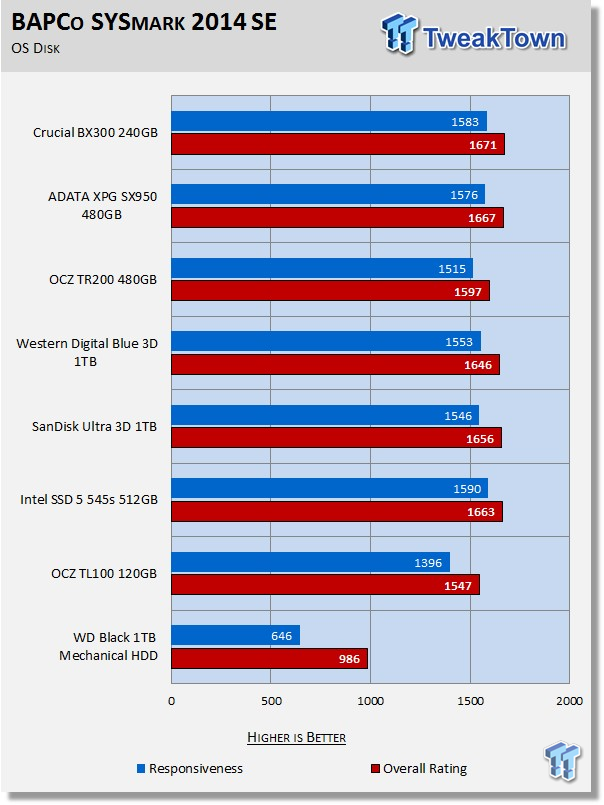
Our systems are much more powerful than the calibration system (1000-point baseline) used by BAPCo, so we ran an OCZ TL100 120GB SATA III SSD to establish a comparison point relative to our test systems. We will be running this test going forward and we will add drives to our chart as we test them.
This test really shows the advantage 2-bit flash has over 3-bit. The BX300 destroys the very powerful SanDisk Ultra 3D 1TB. More importantly, it delivers the one of highest total scores for any SATA SSD we've tested to date. Is the BX300 a Tier-1 performer? You bet it is. Furthermore, it is one of the cheapest SSDs on the market.
Note: we are replacing our PCMark 8 Extended testing with SYSmark because we believe SYSmark is much more relevant for consumer SSD testing.
Benchmarks (Secondary) - IOPS, Response & Transfers
Iometer - Maximum IOPS
Version and / or Patch Used: Iometer 2014
We use Iometer to measure high queue depth performance. (No Partition)
Max IOPS Read
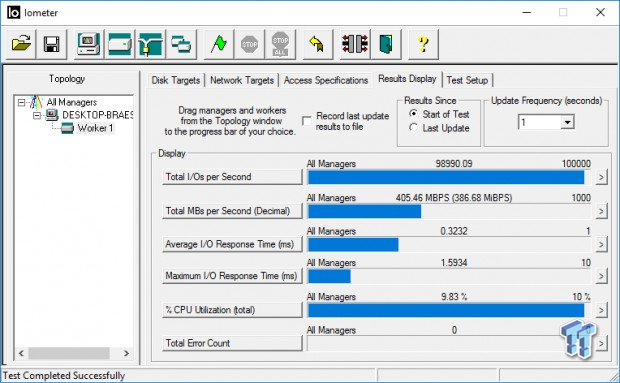
Max IOPS Write
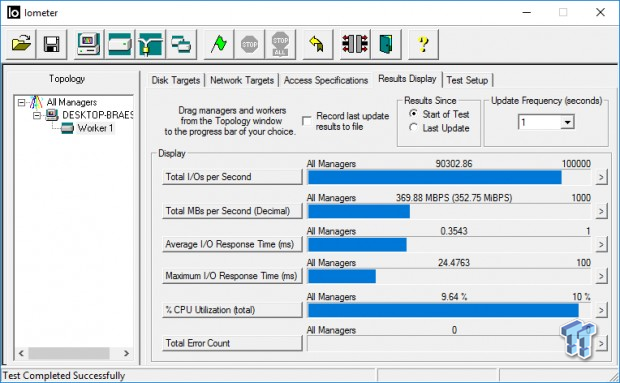
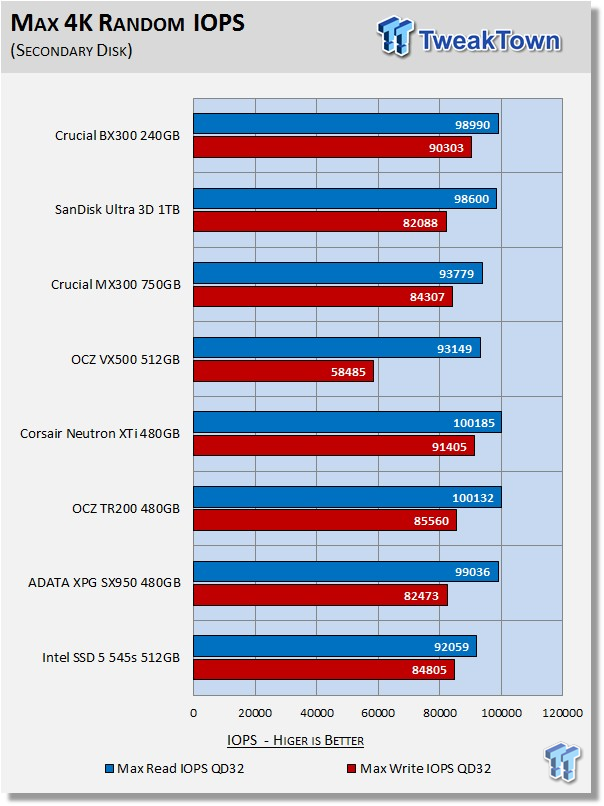
Crucial specs the BX300 240GB for 95K random write IOPS. Maybe with Windows 7 that's possible, but definitely not with Windows 10. On the other hand, we are exceeding factory max random read specs by over 15K.
Iometer - Disk Response
Version and / or Patch Used: Iometer 2014
We use Iometer to measure disk response times. Disk response times are measured at an industry accepted standard of 4K QD1 for both write and read. Each test runs twice for 30 seconds consecutively, with a 5-second ramp-up before each test. We partition the drive/array as a secondary device for this testing.
Avg. Write Response
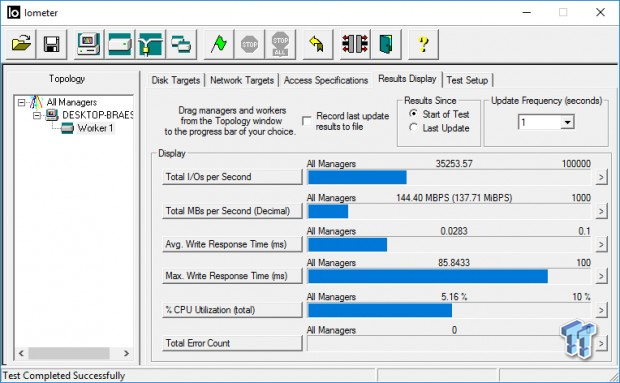
Avg. Read Response
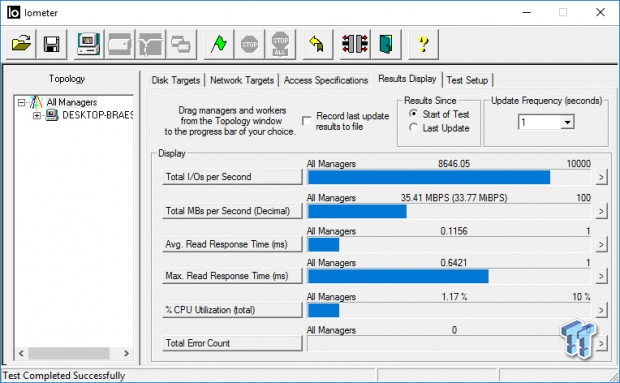
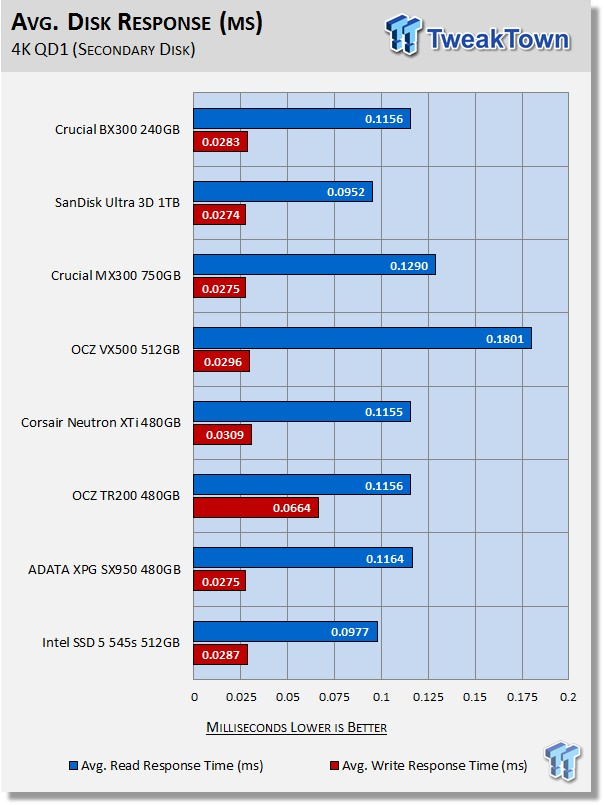
The BX300 delivers about average response times.
DiskBench - Directory Copy
Version and / or Patch Used: 2.6.2.0
We use DiskBench to time a 28.6GB block (9,882 files in 1,247 folders) composed primarily of incompressible sequential and random data as it's transferred from our DC P3700 PCIe NVME SSD to our test drive. We then read from a 6GB zip file that's part of our 28.6GB data block to determine the test drive's read transfer rate. Our system is restarted prior to the read test to clear any cached data, ensuring an accurate test result.
Write Transfer Rate
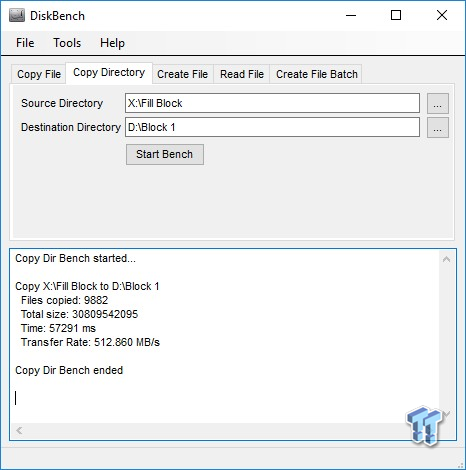
Read Transfer Rate
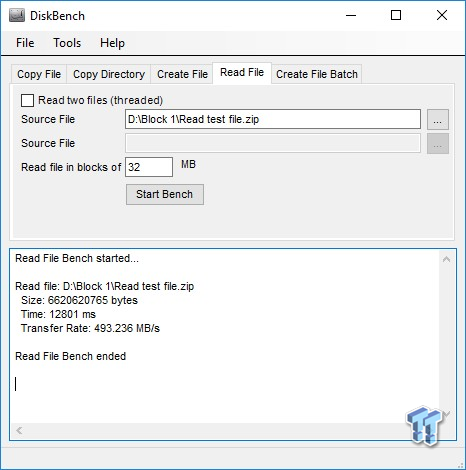
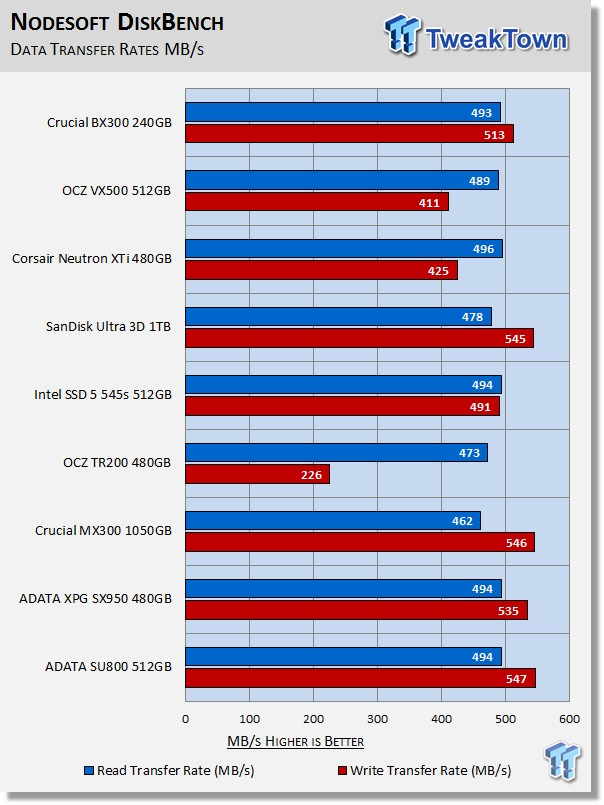
When testing write transfer rates we have a rule of thumb. If any SSD cannot achieve 200MB/s with our write transfer test, that SSD will not receive a TweakTown recommendation. There are many TLC SSDs that do not pass our minimum, but we didn't include those on our chart. Additionally, we recently updated to Windows 10 Anniversary Edition and with that update, sustained write performance greatly increased. This means our previous transfer tests cannot be compared with those run on the newer version on Windows 10. This is the reason we only have a few drives on our chart.
Transfer rates are excellent for a 256GB class SSD.
Benchmarks – 70/30 Mixed Workload & Sustained Sequential Write
70/30 Mixed Workload Test (Sledgehammer)
Version and / or Patch Used: Iometer 2014
Heavy Workload Model
This test hammers a drive so hard we've dubbed it "Sledgehammer". Our 70/30 Mixed Workload test is designed to simulate a heavy-duty enthusiast/workstation steady-state environment. We feel that a mix of 70% read/30% write, full random 4K transfers best represents this type of user environment. Our test allows us to see the drive enter into and reach a steady state as the test progresses.
Phase one of the test preconditions the drive for 1 hour with 128K sequential writes at QD32. Phase two of the test runs a 70% read/30% write at QD32, full random 4K transfer workload on the drive for 1 hour. We log and chart (phase two) IOPS data at 5-second intervals for 1 hour (720 data points). 60 data points = 5 minutes.
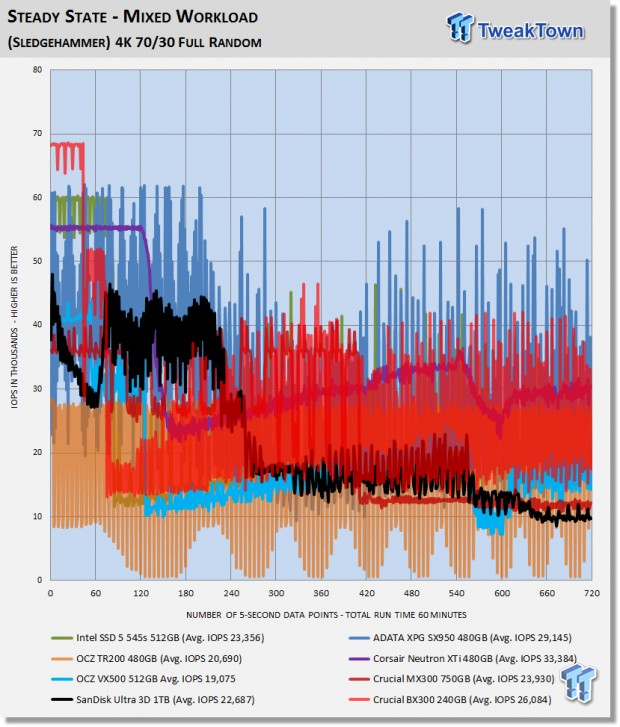
What we like about this test is that it reflects reality. Everything lines up, as it should. Consumer drives don't outperform Enterprise-Class SSDs that were designed for enterprise workloads. Consumer drives based on old technology are not outperforming modern Performance-Class SSDs, etc.
OP and capacity have a lot to do with the results of this test. This is another test where the 240GB capacity of the BX300 we are testing is a disadvantage. However, the BX300 still delivers the goods very well. Only the Neutron XTi and the SX950 are able to deliver better performance.
Sustained Sequential Write
Version and / or Patch Used: Iometer 2014
Heavy Workload Model
We write to the drive for 1 hour with 128K sequential writes at QD32. We log and chart megabytes per second data at 5-second intervals for 1 hour (720 data points). 60 data points = 5 minutes.
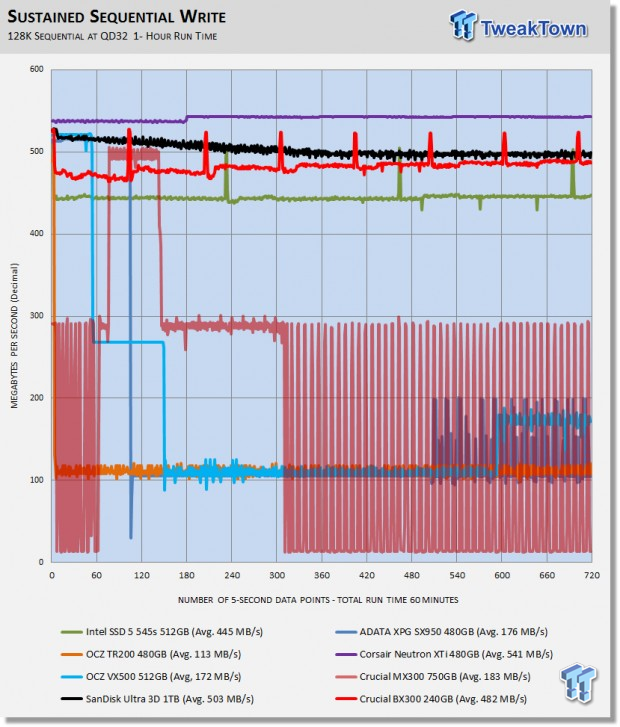
After testing the SX950, we were expecting the BX300 to deliver similar unimpressive sustained write performance, but to our surprise the BX300 handles it with ease. Very impressive sustained write performance to say the least.
Maxed-Out Performance (MOP)
This testing is just to see what the drive is capable of in an FOB (Fresh Out of Box) state under optimal conditions. We are utilizing empty volumes of Windows 10 and Windows Server 2008 R2 64-bit for this testing.
Windows 10 MOP
Crucial BX300 240GB SATA III SSD
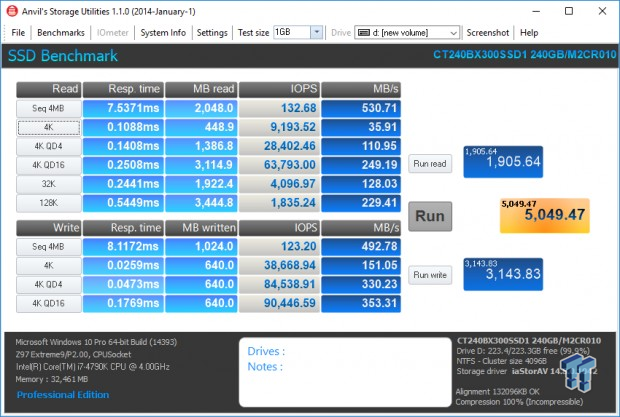
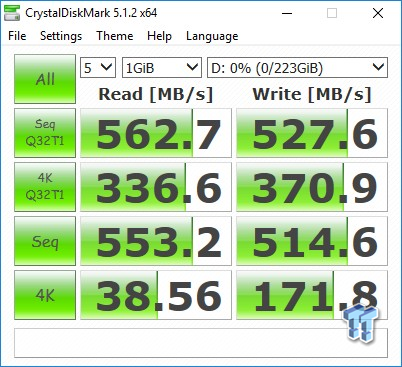
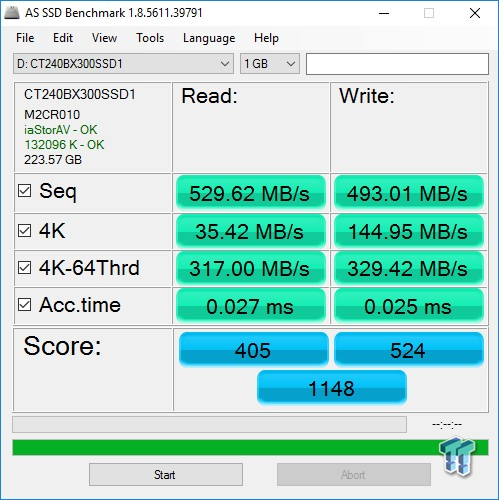
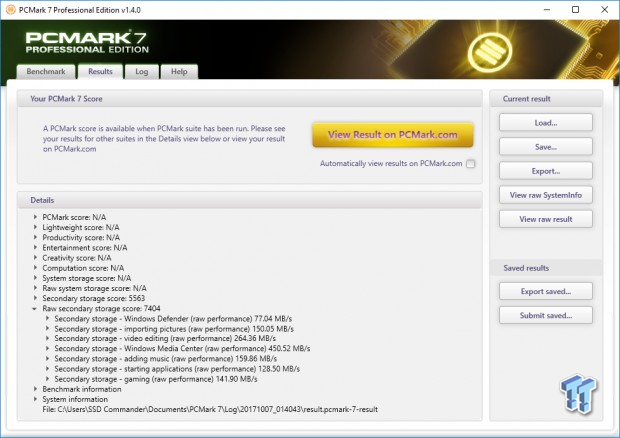
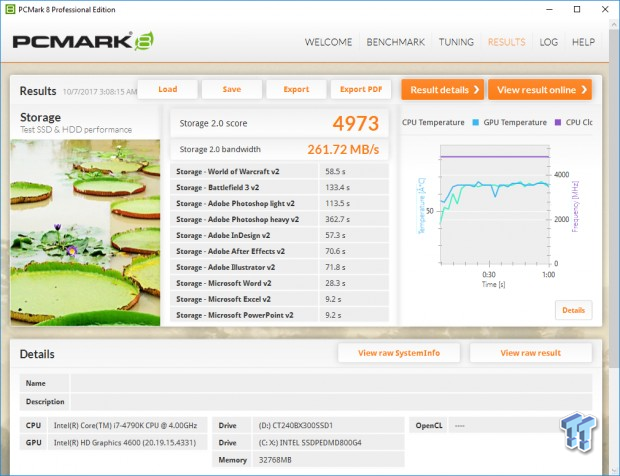
Windows Server 2008 R2 MOP
Crucial BX300 240GB SATA III SSD
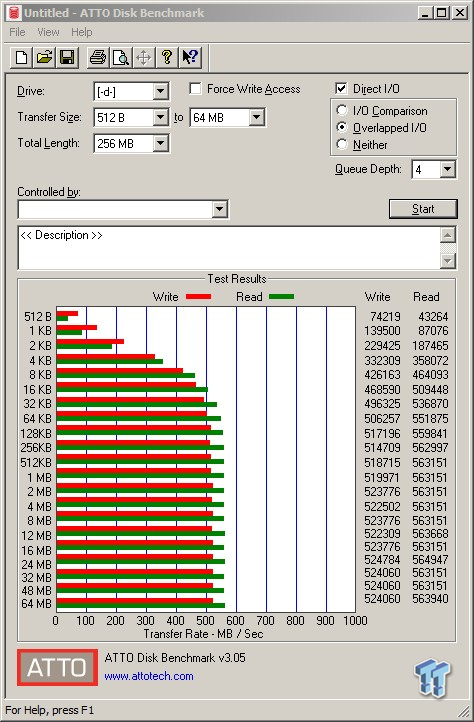
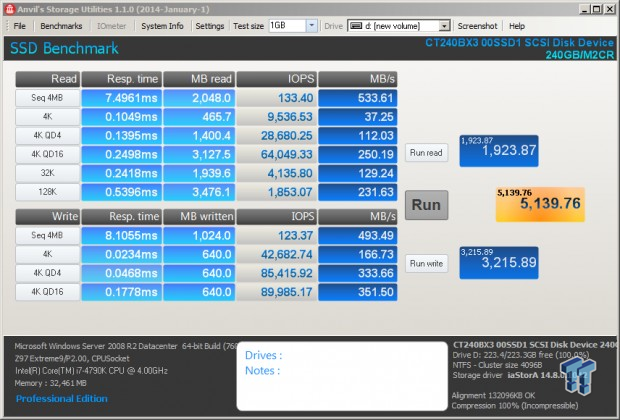
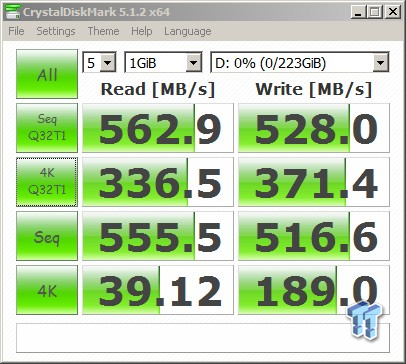
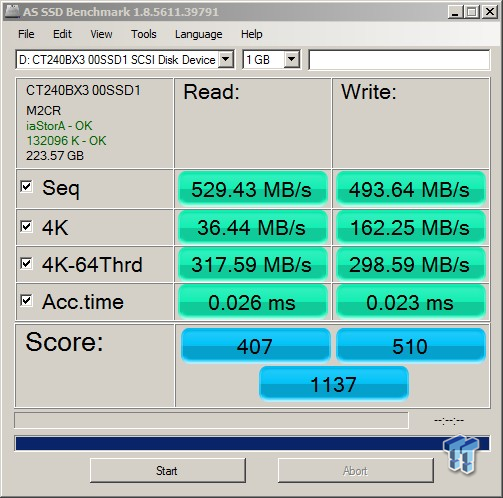
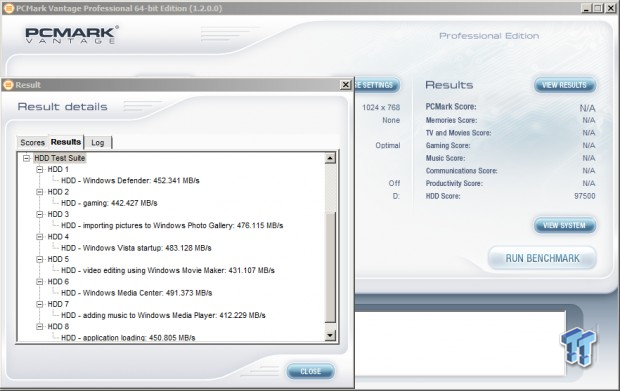
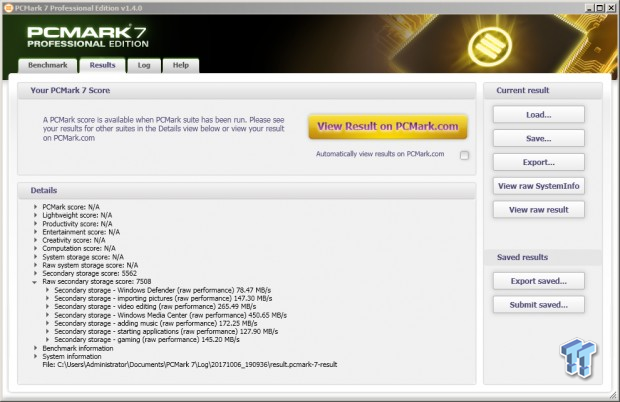
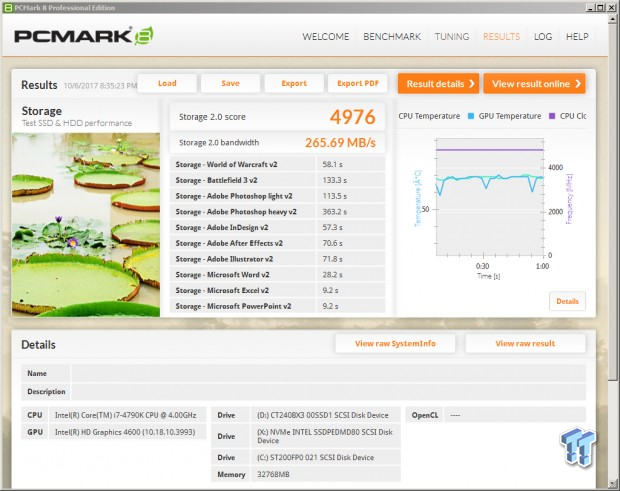
Windows 10 Momentum Cache Enabled
Crucial BX300 240GB SATA III SSD
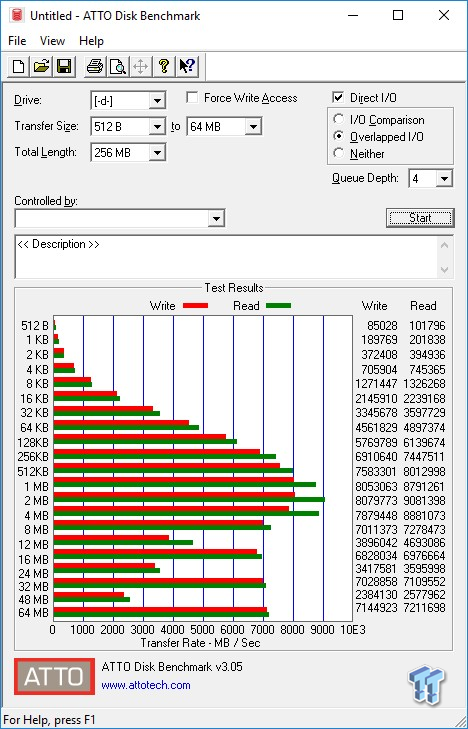
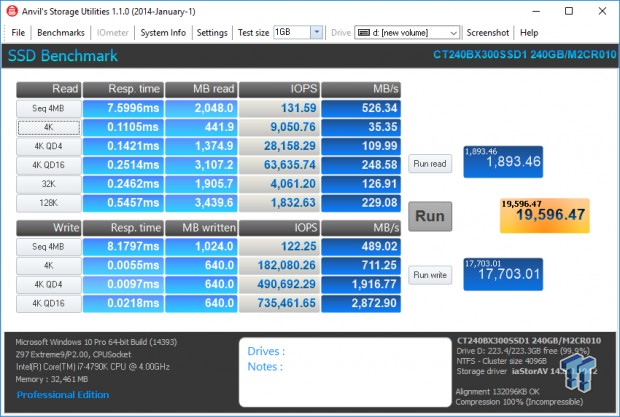
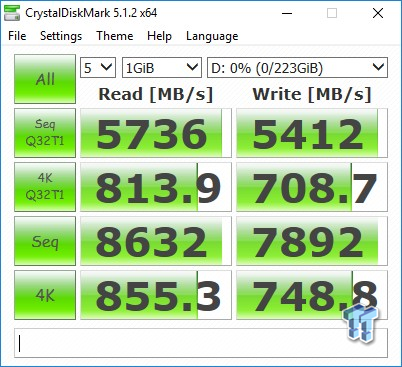
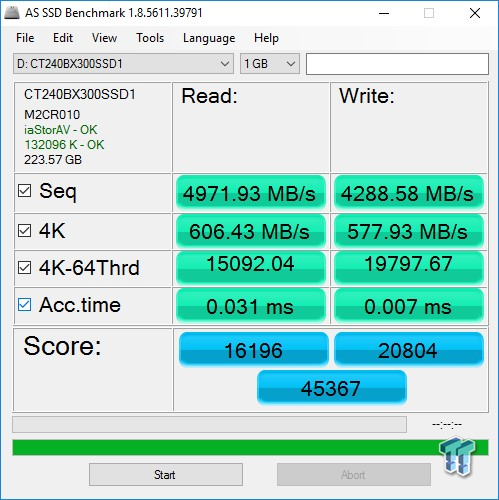
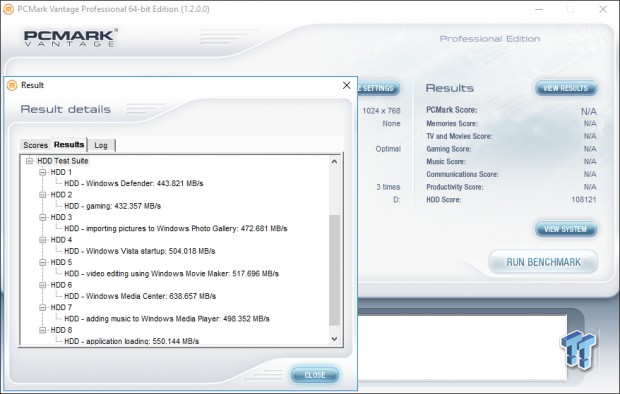
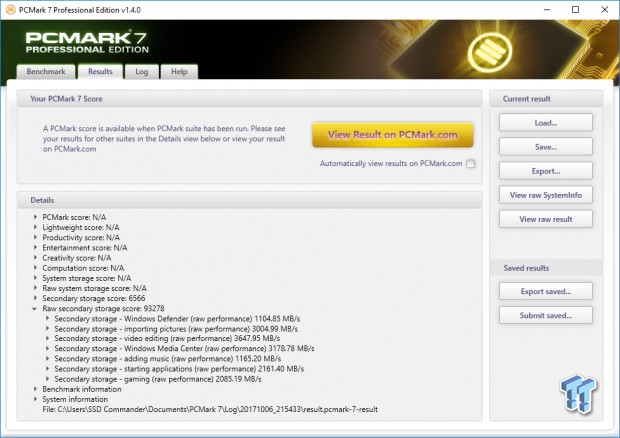
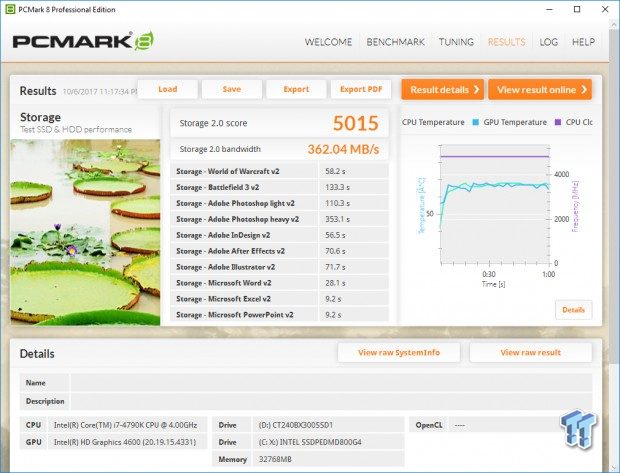
Momentum cache works surprisingly well. The PCMark 8 score is one of the highest we've ever seen from any SATA SSD using caching software.
Final Thoughts
In the end, it all comes down to performance per dollar that equals value. So, what do we have in the BX300? One of the best performing SATA SSDs we've ever tested at about the lowest price per gigabyte we've seen recently. This is a winning combination. The only SATA based SSDs that can outperform the BX300 at 128-480GB are coming from the Samsung camp at a much higher cost. All things considered, we are of the opinion that the BX300 is the best value on the market today.
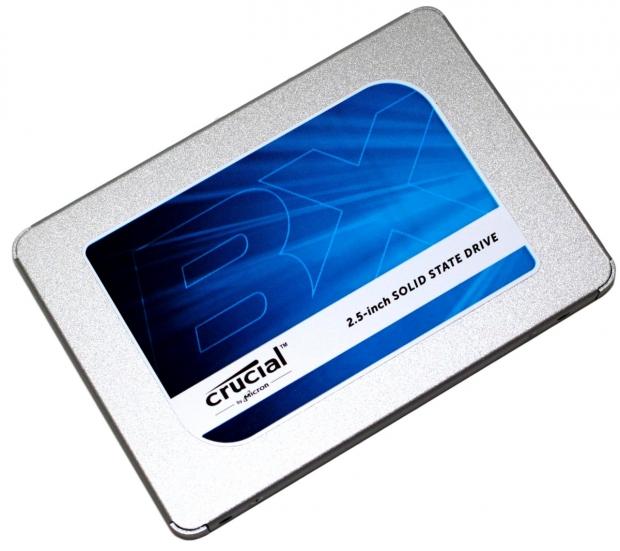
The BX300 delivers a nice balance of synthetic and moderate workload performance. As we noted throughout the review, the BX300 despite its capacity disadvantage delivered far better synthetic performance than the SX950, which is literally the same drive in terms of components. Crucial is working some kind of magic with their firmware or they are using higher grade flash. Either way, the BX300 is the king of the 32-layer Micron flash equipped SATA SSDs.
Undoubtedly, the most impressive performance delivered by the BX300 during our testing came while running SYSmark. The BX300 rewarded us with one of the best scores we've received from any SATA SSD we've tested to date. That's extremely impressive when you consider that SYSmark consists of actual applications running on the system disk. There is no way to optimize firmware for SYSmark. In the real-world, the BX300 is in the top three or four SATA SSDs we've ever tested in terms of performance. In terms of value, we believe it is the top value in SATA SSDs at this time.
User Experience: The Crucial BX300 delivers a Tier-1 SSD experience that rivals any SATA SSD we've ever used. It is very responsive, boots super-fast and handles multi-tasking without skipping a beat. And, when you enable Momentum Cache it gets even better. We came away very impressed with the Crucial BX300 240GB SATA III SSD which is why it is TweakTown recommended.
Pros:
- Application Performance
- MLC Flash
- Pricing
Cons:
- 3-Year Warranty

| Performance | 95% |
| Quality | 98% |
| Features | 95% |
| Value | 99% |
| Overall | 97% |
The Bottom Line: With the lowest prices and some of the best SATA performance we've ever seen, the BX300 is a total win for the consumer.
PRICING: You can find products similar to this one for sale below.
 United
States: Find other tech and computer products like this
over at Amazon.com
United
States: Find other tech and computer products like this
over at Amazon.com
 United
Kingdom: Find other tech and computer products like this
over at Amazon.co.uk
United
Kingdom: Find other tech and computer products like this
over at Amazon.co.uk
 Australia:
Find other tech and computer products like this over at Amazon.com.au
Australia:
Find other tech and computer products like this over at Amazon.com.au
 Canada:
Find other tech and computer products like this over at Amazon.ca
Canada:
Find other tech and computer products like this over at Amazon.ca
 Deutschland:
Finde andere Technik- und Computerprodukte wie dieses auf Amazon.de
Deutschland:
Finde andere Technik- und Computerprodukte wie dieses auf Amazon.de
What's in Jon's PC?
- CPU: AMD Ryzen 7800X 3D
- MOTHERBOARD: GIGABYTE AORUS Master X670E
- RAM: Kingston Fury Renegade 7200MHz 32GB
- GPU: ZOTAC AMP Extreme GeForce RTX 4090
- SSD: Crucial T700 2TB Gen5
- OS: Windows 11 Pro
- COOLER: Lian Li Galahad 360 AIO
- CASE: Lian Li Lancool III
- KEYBOARD: Corsair K65 RGB Mini
- MOUSE: SteelSeries AEROX 5 Wireless
- MONITOR: ASUS ROG Strix PG27AQN 360Hz 1440p ULMB2
Similar Content
Related Tags

